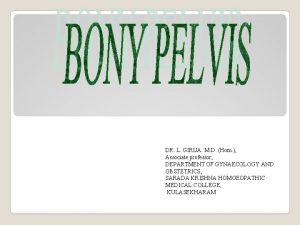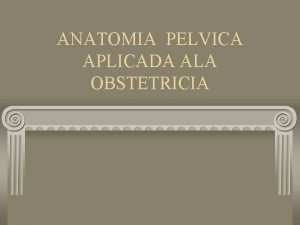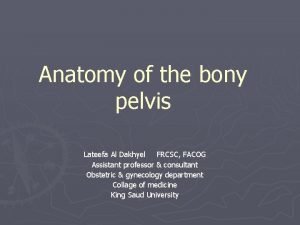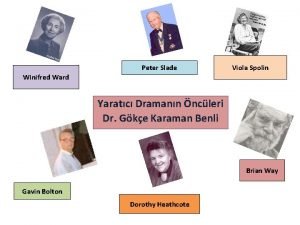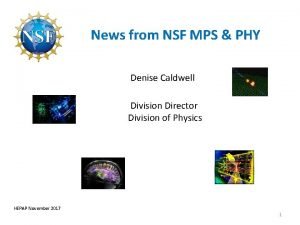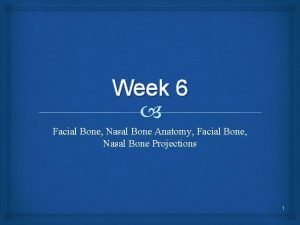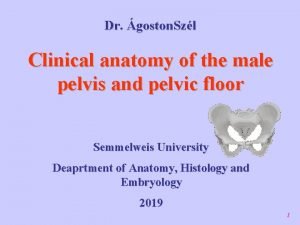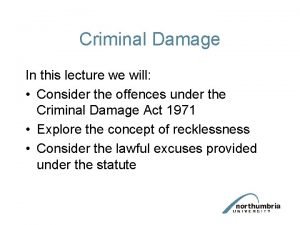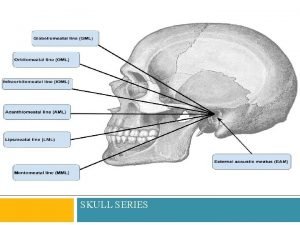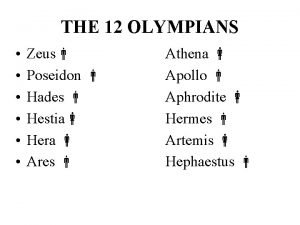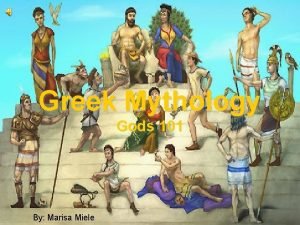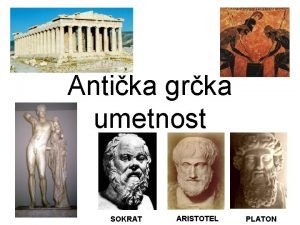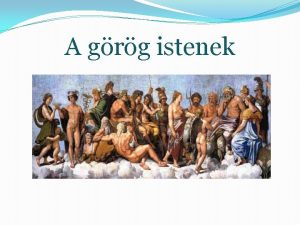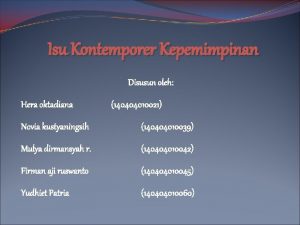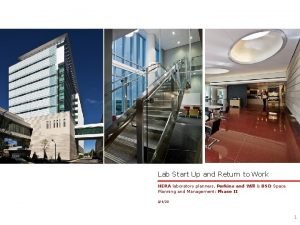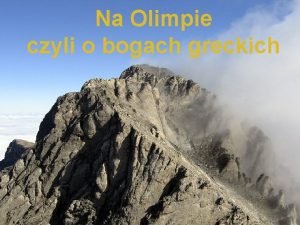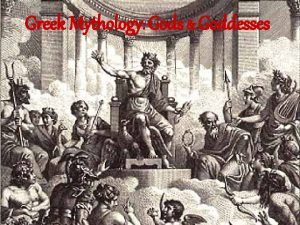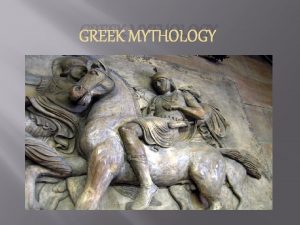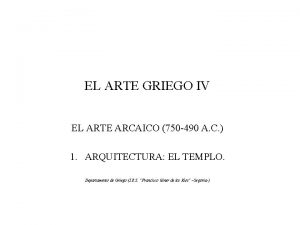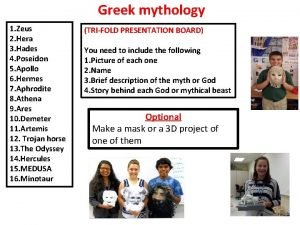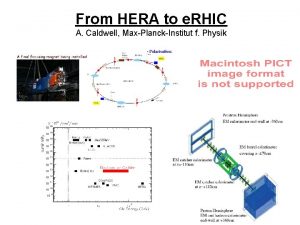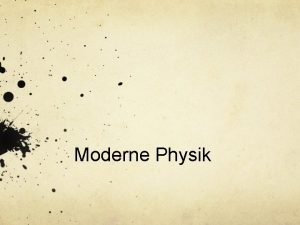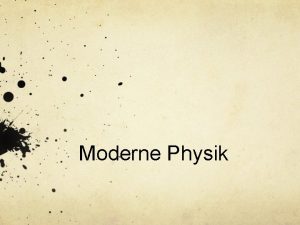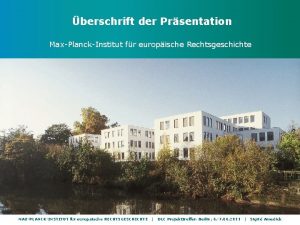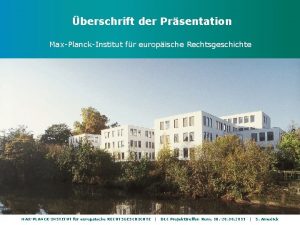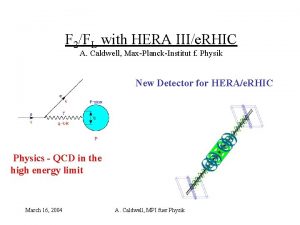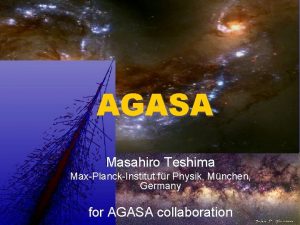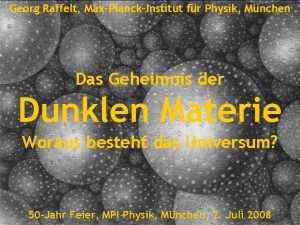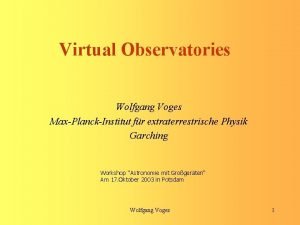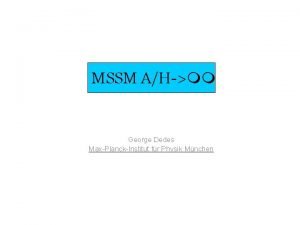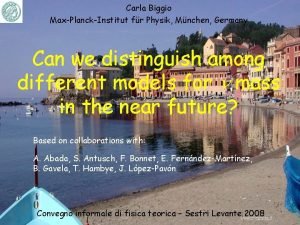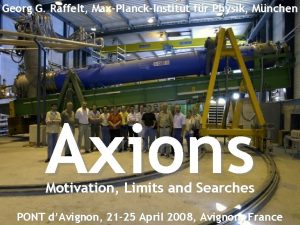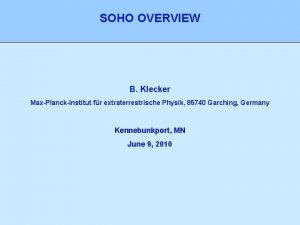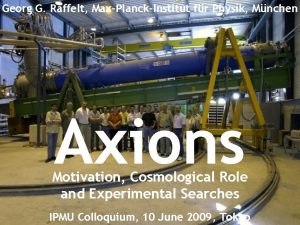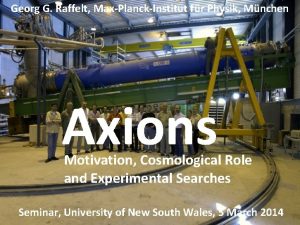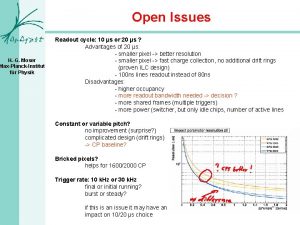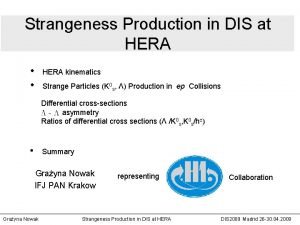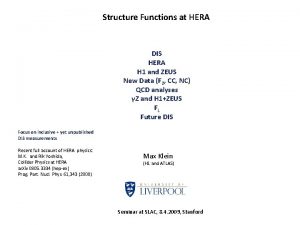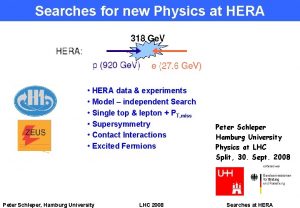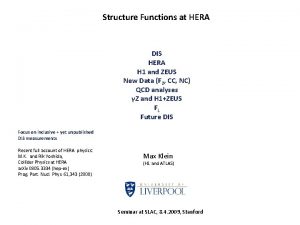Lessons from HERA A Caldwell MaxPlanckInstitut f Physik











































- Slides: 43

Lessons from HERA A. Caldwell, Max-Planck-Institut f. Physik Overview of main results A detector for small/large-x March 17, 2004 A. Caldwell, MPI f. Physik

ZEUS detector Main features: • Solenoid • Focus on central rapidities • Excellent hadronic resolution • general purpose detector March 17, 2004 A. Caldwell, MPI f. Physik 2

p e±L, R H 1 detector: better EM calorimetry, hadronic calorimeter less precise. March 17, 2004 A. Caldwell, MPI f. Physik 3

HERA Kinematics Ee=27. 5 Ge. V EP=920 Ge. V * s=(k+P)2 = (320 Ge. V)2 Q 2=-(k-k`)2 W 2=(q+P)2 r CM energy squared virtualiy *P CM energy squared Transverse distance scale probed: r hc/Q / Mc. Allister, Hofstadter Ee=188 Me. V Bloom et al. 10 Ge. V CERN, FNAL fixed target 500 Ge. V HERA 50 Te. V March 17, 2004 A. Caldwell, MPI f. Physik rmin=0. 4 fm 0. 05 fm 0. 007 fm 0. 0007 fm

What about a longitudinal distance scale ? Proton momentum frame Proton rest frame t = E /Q 2 Lifetime of hadronic = W 2/2 MPQ 2 fluctuations of photon = 1/2 Mpx x=10 -4 1000 fm, x>0. 1 <1 fm x=Q 2/2 P q fraction of P momentum carried by struck quark Proton collection of ‘frozen’ partons on time scale of interaction. Variations of cross section with x, Q 2 attributed to details of proton structure. Sensible at small-x ? March 17, 2004 small x corresponds to scattering of dipole with proton. At large Q 2, dipole small, reduced radiation, color transparency. At small Q 2, highly evolved dipole, hadron-hadron scattering. A. Caldwell, MPI f. Physik 5

Proton momentum frame Proton rest frame d 2 /d. W d. Q 2 = ( T + L) Rutherford d 2 /dxd. Q 2=2 2/x. Q 4[(1+(1 -y)2)F 2 - y 2 FL] F 2 = f e 2 f x {q(x, Q 2) + q(x, Q 2) } ef is quark charge q(x, Q 2) is quark density F 2 = Q 2/4 2 ( T + L) FL = 0 in LO (QPM), non-zero after gluon radiation. Key test of our understanding March 17, 2004 G is flux of photons T, L are cross sections for transversely, longitudinally polarized photons to scatter from proton is the relative flux In dipole model, photon qq wfn extracted from T, L A. Caldwell, MPI f. Physik 6

Hadron-hadron scattering cross section versus CM energy *P scattering cross section versus CM energy (Q 2 0). Same energy dependence observed s 0. 08 vs W 2 0. 08 Higher energy – more time for evolution of wfns - short lived fluctuations become visible. March 17, 2004 A. Caldwell, MPI f. Physik 7

Cross sections as a function of Q 2 The rise of F 2 with decreasing x observed at HERA is strongly dependent on Q 2 Equivalently, strongly rising *P cross section with W at high Q 2 March 17, 2004 A. Caldwell, MPI f. Physik

The behavior of the rise with Q 2 Below Q 2 0. 5 Ge. V 2, see same energy dependence as observed in hadron-hadron interactions. Observe transition from partons to hadrons (constituent quarks) in data. Distance scale 0. 3 fm ? ? What physics causes this transition ? Hadron-hadron scattering energy dependence (Donnachie-Landshoff) March 17, 2004 A. Caldwell, MPI f. Physik

In general, NLO p. QCD (DGLAP) fits do a good job of reproducing the data over the full measurement range. March 17, 2004 A. Caldwell, MPI f. Physik 10

Analysis of F 2 in terms of parton densities (quarks and gluons) NLO DGLAP fits can follow the data accurately, yield parton densities. BUT: • many free parameters (1830) • form of parametrization fixed (not given by theory) Constraints, e. g. , dsea=usea put in by hand. Is this correct ? Need more constraints to untangle parton densities. March 17, 2004 A. Caldwell, MPI f. Physik 11

See breakdown of NLO DGLAP approach. . . Gluon density known with good precision at larger Q 2. For Q 2=1, gluons go negative. NLO, so not impossible, BUT – cross sections such as L also negative ! March 17, 2004 A. Caldwell, MPI f. Physik 12

FL shows tremendous variations when attempt to calculate at different orders. But FL is an observable – unique result. FL is hard to measure but a very sensitive test. Should be measured. March 17, 2004 A. Caldwell, MPI f. Physik 13

There also significant uncertainties at large x Fractional error March 17, 2004 A. Caldwell, MPI f. Physik

Statistics at large-x from HERA II From 1 fb-1 with Ep=920 Ge. V. 15% measurement at x>0. 7. Will be a first measurement of this quantity. March 17, 2004 A. Caldwell, MPI f. Physik

Detector acceptance, performance: Key issue for detector builders Main detector acceptance Shifted vertex run The Q 2=1 Ge. V 2 region not covered continuously. Very interesting region focus of new experiment. Beamline Cal Large-x also has limited coverage in DIS regime. March 17, 2004 A. Caldwell, MPI f. Physik 16

Detector Acceptance and Kinematics e P Small-x: scattered particles in electron direction. Scattered electron energy+angle determines kinematics e P Large-x: scattered jet in proton direction. Electron angle depends on Q 2. Jet energy gives x. Jet acceptance critical. March 17, 2004 A. Caldwell, MPI f. Physik 17

Diffractive Surprises ‘Standard DIS event’ Detector activity in proton direction Diffractive event No activity in proton direction March 17, 2004 A. Caldwell, MPI f. Physik

Diffraction 1. 2. There is a large diffractive cross section, even in DIS (ca. 20 %) The diffractive and total cross sections have similar energy dependences. Data suggests simple physics – what is it ? Key detector issues: • Need to guarantee proton intact. • Cover full W range • Good MX resolution Experience: measuring scattered proton gives cleanest measurements, but acceptance limited in PT, x. L. Tag/reject proton breakup gives full acceptance, but need to work on PT resolution. March 17, 2004 A. Caldwell, MPI f. Physik

• Exclusive Processes (VM and DVCS) VM Clean process, but • was it really elastic ? • limited W coverage – depends on rapidity coverage of tracking system. March 17, 2004 A. Caldwell, MPI f. Physik 20

Energy dependence of exclusive processes ep e. Vp (V= , , , J/ ) ep e p (as QCD process) Summary of different Vector mesons Rise similar again to that seen in total cross section. Need bigger lever arm in W to see energy dependence more precisely. Need to distinguish elastic from proton dissociation events for small impact parameter scans of proton. March 17, 2004 A. Caldwell, MPI f. Physik

Forward jet and particle production p 0 • Select energetic forward pions, with k. Tp ~ Q 2, in low x DIS events. • Simple DGLAP description fails. • BFKL reasonable agreement. • CCFM fails. • Jet results similar. • Parton radiation at low x not well understood! March 17, 2004 A. Caldwell, MPI f. Physik 22

In the end, we need to understand QCD radiation and to solve QCD at large distance scales – non-perturbative physics ! track March 17, 2004 CAL A. Caldwell, MPI f. Physik 23

Open Questions – Next Steps • Measure the behavior of inclusive, diffractive and exclusive reactions in the region near Q 2=1 Ge. V 2 to understand parton to hadron transition. Best is full acceptance detector for scattered electrons at small angles. • Measure FL over widest possible kinematical range, as this is a crucial observable for testing our understanding of radiation processes in QCD. Need large y small electron energies. Start with maximum possible electron beam energy, good e/ separation, electron resolution. • Measure exclusive processes (VM production, DVCS) over wide W range to precisely pin down energy dependence of cross section. Need tdependence of cross sections to get 3 -D map of proton. Need to verify scattering elastic. Maximum rapidity coverage of tracking, good PT resolution. March 17, 2004 A. Caldwell, MPI f. Physik 24

Open Questions – Next Steps • Measure forward jet cross sections over widest possible rapidity range, to study radiation processes over the full rapidity range from the proton to the scattered quark. Need calorimetry and tracking at high rapidity. • Measure structure functions at high-x. Need large luminosities, calorimetry at high rapidity. • And, do it all with nuclei ! March 17, 2004 A. Caldwell, MPI f. Physik 25

HERA II 2003 -2007 Spin Rotators successfully implemented New physics possibilities due to big increase in data sets, polarization of the beam March 17, 2004 A. Caldwell, MPI f. Physik

EW Physics Measure CC cross sections as a function of the lepton charge and polarization. Sensitive to right-handed weak currents (up to WR=400 Ge. V). Classic test of EW interaction. March 17, 2004 A. Caldwell, MPI f. Physik helicity suppression

Deeply Inelastic e. P scattering: Charged Current Neutral Current e- W- , W- scatters on u, c, d, s e+ W+ , W+ scatters on d, s, u, c Measure distribution of quarks and gluons in the proton (structure functions) as a function of a transverse resolution scale (Q – 4 momentum transferred) and a longitudinal momentum scale (x – fraction of proton momentum). March 17, 2004 A. Caldwell, MPI f. Physik 28

Large-x Charged Current interactions allow to constrain separately u and d valence quark density at high x and Q 2 --- _ _ (e p) ~ x (u+c) + (1 -y 2) x (d+s) _ _ + (e p) ~ x (u+c) + (1 -y 2) x (d+s) Put emphasis on e. R+ to get max sensitivity to d(x), s(x) [u(x) primarily from F 2 NC]. Require >500 pb-1 for large -x measurements. March 17, 2004 A. Caldwell, MPI f. Physik

HERA-III Initiative Two letters of intent were submitted to the DESY PRC (May 7, 8 2002) • H 1 Collaboration Focus initially on e. D: isospin symmetry of sea at small-x uv/dv at large-x diffraction on n, D Discuss also interest in: e. A, F 2, FL at small Q 2, forward jets, spin structure • New Collaboration Optimized detector for precision structure function measurements, forward jets and particle production over a large rapidity interval (e. P, e. D, e. A) March 17, 2004 A. Caldwell, MPI f. Physik 30

Possible upgrades of H 1 detector Upgrade in electron direction for low Q 2 F 2 and FL measurements + very forward proton, neutron detectors Upgrade in proton direction forward particle, jets measurements March 17, 2004 A. Caldwell, MPI f. Physik 31

Precision e. D measurements • Universality of PDF‘s at small-x, isospin symmetry Can measure F 2 p-F 2 n w/o nuclear corrections if can tag scattered nucleon March 17, 2004 A. Caldwell, MPI f. Physik 32

• Flavor dependence at high-x Simulation with H 1 based on 50 pb -1 Behavior of F 2 p/F 2 n as x 1 SU(6) symmetry Dominant scalar diquark F 2 p/F 2 n = 2/3 F 2 p/F 2 n = 1/4 Can measure this ratio w/o need to correct for nuclear effects if can tag scattered nucleon. March 17, 2004 A. Caldwell, MPI f. Physik 33

A new detector to study strong interaction physics p Si tracking stations Hadronic Calorimeter e March 17, 2004 EM Calorimeter Compact – fits in dipole magnet with inner radius of 80 cm. Long - |z| 5 m A. Caldwell, MPI f. Physik

The focus of the detector is on providing complete acceptance in the low Q 2 region where we want to probe the transition between partons and more complicated objects. Tracking acceptance Q 2=100 Q 2=1 Q 2=0. 1 March 17, 2004 W=0 A. Caldwell, MPI f. Physik W=315 Ge. V 35

Tracking acceptance in proton direction Huge increase in tracking acceptance compared to H 1 And ZEUS. Very important forward jet, particle production, particle correlation studies. ZEUS, H 1 This region covered by calorimetry Accepted 4 Si stations crossed. March 17, 2004 A. Caldwell, MPI f. Physik 36

FL Measurement Range d 2 /dxd. Q 2=2 2/x. Q 4[ (1+(1 -y)2)F 2(x, Q 2) - y 2 FL(x, Q 2) ] Fix x, Q 2. Use different beam energies to vary y. Critical issue: e/ separation FL can be measured precisely in the region of maximum interest. This will be a strong test of our understanding of QCD radiation. March 17, 2004 A. Caldwell, MPI f. Physik 37

High x, large W – unmeasured region Very forward calorimeter allows measurement of high energy, forward jets, and access to high-x events at moderate Q 2 Cross sections calculated from ALLM March 17, 2004 A. Caldwell, MPI f. Physik 38

Forward jet cross sections: see almost full cross section ! New region Range covered by H 1, ZEUS March 17, 2004 A. Caldwell, MPI f. Physik 39

Very large gain also for vector meson, DVCS studies. Can measure cross sections at small, large W, get much more precise determination of the energy dependence. Can also get rid of proton dissociation background by good choice of tagger: 0 5 10 15 20 HERA-1 W=0 HERA-3 50 100 150 200 250 300 Ge. V FHD- hadron CAL around proton pipe at z=20 m FNC-neutron CAL at z=100 m March 17, 2004 A. Caldwell, MPI f. Physik 40

Quote from DESY summary to HGF 5 Year Planning March 17, 2004 A. Caldwell, MPI f. Physik

Physics/Detector studies for e. RHIC 2 x 14 Si tracking stations March 17, 2004 A. Caldwell, MPI f. Physik

Preliminary summary of e. RHIC detector/physics studies: 1. 2. 3. 4. 5. 6. 7. EIC/HERA III would allow precision measurements in the transition region observed at HERA at small-x (<10 -2) FL measurements would be possible in an interesting kinematical range. The structure functions could be measured at large x over a wide range of Q 2. New territory. Particle production/correlations over a wide rapidity range could be explored. e. A collisions would provide a different angle on studying systems with a large gluon density. Performance for exclusive states should be greatly improved. Higher energies smaller x (important for CGC type issues). March 17, 2004 A. Caldwell, MPI f. Physik 43
 James brian caldwell ii
James brian caldwell ii Rachetic
Rachetic Diametros de pelvis
Diametros de pelvis Pelvic inlet boundaries
Pelvic inlet boundaries J caldwell
J caldwell Angela janet caldwell
Angela janet caldwell Jane caldwell
Jane caldwell Rumberger kirk & caldwell salary
Rumberger kirk & caldwell salary Caldwell cboc
Caldwell cboc Brian way
Brian way Kris caldwell
Kris caldwell Denise caldwell nsf
Denise caldwell nsf Anne caldwell solicitor
Anne caldwell solicitor Acanthion anatomy
Acanthion anatomy Deans intraseptal alveoloplasty
Deans intraseptal alveoloplasty Linea terminalis
Linea terminalis Selahattin çoruh ve drama
Selahattin çoruh ve drama Cystiv fibrosis
Cystiv fibrosis Caldwell lacuna
Caldwell lacuna Oml line
Oml line Caldwell county department of social services
Caldwell county department of social services Zeus and hera's son
Zeus and hera's son Considared
Considared Miele service greece
Miele service greece Lapit i kentaur
Lapit i kentaur Artemisz jelképe
Artemisz jelképe Hera oktadiana
Hera oktadiana Materiali per acquedottistica modena
Materiali per acquedottistica modena Hera lab planners
Hera lab planners Atrybuty hery
Atrybuty hery Hades roman name
Hades roman name Story of hera
Story of hera What weaknesses does zeus have
What weaknesses does zeus have Bogw
Bogw Grecki bóg kowali
Grecki bóg kowali Natalia to mitologiczna opiekunka
Natalia to mitologiczna opiekunka Queen of the gods
Queen of the gods Athena's roman name
Athena's roman name Hera roman name
Hera roman name Apolo atributos
Apolo atributos Rewla khanpur red light area
Rewla khanpur red light area Hestia roman name and symbol
Hestia roman name and symbol Templo de hera en paestum planta
Templo de hera en paestum planta Hera interesting facts
Hera interesting facts

